A Machine Learning-Enhanced 3D Reverse Design Approach to Personalized Garments in Pursuit of Sustainability
Abstract
1. Introduction
- Reducing the difficulties of personalized garment design for fashion designers (especially the novice) and lessening the heavy dependency on the designer’s experiences and skills by modelling profound design knowledge using ML techniques;
- Providing a new solution to overcome the technical drawbacks of current 3D reverse design methods for garment design by using ML techniques to enhance the reliability of flattened 2D garment patterns;
- Boosting the emergence of an innovative personalized design approach for fashion products (i.e., garments, footwear, headwear, etc.) by integrating fit evaluation and an adaptive mechanism into the conventional 3D design process;
- Facilitating the industrialized application of 3D reverse design technology in the fashion industry by resolving the current technical bottlenecks using intelligent computational tools;
- Offering a promising solution for fashion companies aiming for sustainability by designing quality fashion products in a more reliable, intuitive, accurate, efficient, and economical manner.
2. Research Methodology
2.1. Literature Review
2.2. General Research Scheme
2.3. Formalization
2.4. Acquisition of the Modelling Data
2.4.1. Acquisition of the Learning Data for Model 1 (Experiment I)
2.4.2. Acquisition of the Learning Data for Model 2 (Experiment II)
3. Construction of the Computational Tools for Optimizing the 3D Reverse Design Method
3.1. Creation of Knowledge Base for Garment Fit Prediction (Model 1)
3.2. Creation of Knowledge Base for Garment Pattern Adjustment (Model 2)
3.3. Creation of the Comprehensive Evaluation Model (Model 3)
4. Application, Validation, and Discussion
4.1. Application in the Customization of Personalized Tight-Fitting Garments
4.1.1. Definition of the Consumer Profile for Tight-Fitting Garments
4.1.2. Design of the 3D Basic Garment
4.1.3. Fit Evaluation of the Basic Garment
4.1.4. Adjustment of the Basic Garment
4.1.5. Design of the Production Pattern Panel
4.2. Application in the Customization of Personalized Loose-Fitting Garments
4.2.1. Definition of the Consumer Profile for Loose-Fitting Garments
4.2.2. Design, Evaluation, and Adjustment of the Desired Loose-Fitting Garment
4.3. Comparison between the ML-Enhanced 3D Reverse Design Method and the Traditional 2D Method
4.4. Extention to Development of a Sustainable New O2O Business Model in the Fashion Industry
5. Conclusions
Author Contributions
Funding
Institutional Review Board Statement
Informed Consent Statement
Data Availability Statement
Acknowledgments
Conflicts of Interest
References
- Khajavi, S.H. Additive Manufacturing in the Clothing Industry: Towards Sustainable New Business Models. Appl. Sci. 2021, 11, 8994. [Google Scholar] [CrossRef]
- Benkirane, R.; Thomassey, S.; Koehl, L.; Perwuelz, A. A New Longevity Design Methodology Based on Consumer-Oriented Quality for Fashion Products. Sustainability 2022, 14, 7696. [Google Scholar] [CrossRef]
- Multala, B.; Wagner, J.; Wang, Y. Durability standards and clothing libraries for strengthening sustainable clothing markets. Ecol. Econ. 2022, 194, 107358. [Google Scholar] [CrossRef]
- Peleg Mizrachi, M.; Tal, A. Sustainable Fashion-Rationale and Policies. Encyclopedia 2022, 2, 1154–1167. [Google Scholar] [CrossRef]
- Wu, B.; Xie, X.; Ke, W.; Bao, H.; Duan, Z.; Jin, Z.; Dai, X.; Hong, Y. Merchandising for Sustainable Fashion: A Systematic Literature Review. Sustainability 2022, 14, 13422. [Google Scholar] [CrossRef]
- Nouinou, H.; Asadollahi-Yazdi, E.; Baret, I.; Nguyen, N.Q.; Terzi, M.; Ouazene, Y.; Yalaoui, F.; Kelly, R. Decision-making in the context of Industry 4.0: Evidence from the textile and clothing industry. J. Clean. Prod. 2023, 391, 136184. [Google Scholar] [CrossRef]
- Environmental Sustainability in the Fashion Industry. 23 February 2023. Available online: https://www.genevaenvironmentnetwork.org/resources/updates/sustainable-fashion/#scroll-nav__1 (accessed on 5 March 2023).
- Perret, J.K.; Schuck, K.; Hitzegrad, C. Production Scheduling of Personalized Fashion Goods in a Mass Customization Environment. Sustainability 2022, 14, 538. [Google Scholar] [CrossRef]
- Avadanei, M.L.; Olaru, S.; Dulgheriu, I.; Ionesi, S.D.; Loghin, E.C.; Ionescu, I. A New Approach to Dynamic Anthropometry for the Ergonomic Design of a Fashionable Personalised Garment. Sustainability 2022, 14, 7602. [Google Scholar] [CrossRef]
- Fathi, M.; Ghobakhloo, M. Enabling Mass Customization and Manufacturing Sustainability in Industry 4.0 Context: A Novel Heuristic Algorithm for in-Plant Material Supply Optimization. Sustainability 2020, 12, 6669. [Google Scholar] [CrossRef]
- Dangelico, R.M.; Alvino, L.; Fraccascia, L. Investigating the antecedents of consumer behavioral intention for sustainable fashion products: Evidence from a large survey of Italian consumers. Technol. Forecast. Soc. Change 2022, 185, 122010. [Google Scholar] [CrossRef]
- Orminski, J.; Tandoc, E.C., Jr.; Detenber, B.H. Sustainablefashion–A Conceptual Framework for Sustainable Fashion Discourse on Twitter. Environ. Commun. 2021, 15, 115–132. [Google Scholar] [CrossRef]
- Chaw Hlaing, E.; Krzywinski, S.; Roedel, H. Garment prototyping based on scalable virtual female bodies. Int. J. Cloth. Sci. Technol. 2013, 25, 184–197. [Google Scholar] [CrossRef]
- Harwood, A.R.G.; Gill, J.; Gill, S. JBlockCreator: An open source, pattern drafting framework to facilitate the automated manufacture of made-to-measure clothing. SoftwareX 2020, 11, 100365. [Google Scholar] [CrossRef]
- Jin, P.; Fan, J.; Zheng, R.; Chen, Q.; Liu, L.; Jiang, R.; Zhang, H. Design and Research of Automatic Garment-Pattern-Generation System Based on Parameterized Design. Sustainability 2023, 15, 1268. [Google Scholar] [CrossRef]
- Hajishirzi, R.; Costa, C.J.; Aparicio, M. Boosting Sustainability through Digital Transformation’s Domains and Resilience. Sustainability 2022, 14, 1822. [Google Scholar] [CrossRef]
- Holzmann, P.; Gregori, P. The promise of digital technologies for sustainable entrepreneurship: A systematic literature review and research agenda. Int. J. Inf. Manag. 2023, 68, 102593. [Google Scholar] [CrossRef]
- Broccardo, L.; Zicari, A.; Jabeen, F.; Bhatti, Z.A. How digitalization supports a sustainable business model: A literature review. Technol. Forecast. Soc. Change 2023, 187, 122146. [Google Scholar] [CrossRef]
- Lei, G.; Li, X. Review of digital pattern-making technology in garment production. J. Text. Res. 2022, 43, 203–209. [Google Scholar]
- Liu, K.; Wu, H.; Zhu, C.; Wang, J.; Zeng, X.; Tao, X.; Bruniaux, P. An evaluation of garment fit to improve customer body fit of fashion design clothing. Int. J. Adv. Manuf. Technol. 2022, 120, 2685–2699. [Google Scholar] [CrossRef]
- Li, J.; Lu, G. Modeling 3D garments by examples. Comput.-Aided Des. 2014, 49, 28–41. [Google Scholar] [CrossRef]
- Giri, C.; Jain, S.; Zeng, X.; Bruniaux, P. A Detailed Review of Artificial Intelligence Applied in the Fashion and Apparel Industry. IEEE Access 2019, 7, 95376–95396. [Google Scholar] [CrossRef]
- Guan, C.; Qin, S.; Ling, W.; Ding, G. Apparel recommendation system evolution: An empirical review. Int. J. Cloth. Sci. Technol. 2016, 28, 854–879. [Google Scholar] [CrossRef]
- Liu, K.; Zeng, X.; Bruniaux, P.; Tao, X.; Kamalha, E.; Wang, J. Garment Fit Evaluation Using Machine Learning Technology. In Artificial Intelligence for Fashion Industry in the Big Data Era; Thomassey, S., Zeng, X., Eds.; Springer: Singapore, 2018; pp. 273–288. [Google Scholar]
- Liu, K.; Zhu, C.; Tao, X.; Bruniaux, P.; Zeng, X.; Wang, J. A Novel Evaluation Technique for Human Body Perception of Clothing Fit. Multimedia Tools and Applications. 2023. Available online: https://link.springer.com/article/10.1007/s11042-023-14530-x (accessed on 5 March 2023).
- González Rodríguez, G.; Gonzalez-Cava, J.M.; Méndez Pérez, J.A. An intelligent decision support system for production planning based on machine learning. J. Intell. Manuf. 2020, 31, 1257–1273. [Google Scholar] [CrossRef]
- Papachristou, E.; Chrysopoulos, A.; Bilalis, N. Machine learning for clothing manufacture as a mean to respond quicker and better to the demands of clothing brands: A Greek case study. Int. J. Adv. Manuf. Technol. 2021, 115, 691–702. [Google Scholar] [CrossRef]
- Tsz-Ho, K.; Yan-Qiu, Z.; Charlie, W.; Yong-Jin, L. Styling Evolution for Tight-Fitting Garments. IEEE Trans. Vis. Comput. Graph. 2016, 22, 1580–1591. [Google Scholar]
- Bartle, A.; Sheffer, A.; Kim, V.; Kaufman, D.M.; Vining, N.; Berthouzoz, F. Physics-driven pattern adjustment for direct 3D garment editing. ACM Trans. Graph. TOG 2016, 35, 2925896. [Google Scholar] [CrossRef]
- Liu, K.; Wang, J.; Zhu, C.; Hong, Y. Development of upper cycling clothes using 3D-to-2D flattening technology and evaluation of dynamic wear comfort from the aspect of clothing pressure. Int. J. Cloth. Sci. Technol. 2016, 28, 736–749. [Google Scholar] [CrossRef]
- Abtew, M.A.; Bruniaux, P.; Boussu, F.; Loghin, C.; Cristian, I.; Chen, Y.; Wang, L. A systematic pattern generation system for manufacturing customized seamless multi-layer female soft body armour through dome-formation (moulding) techniques using 3D warp interlock fabrics. J. Manuf. Syst. 2018, 49, 61–74. [Google Scholar] [CrossRef]
- Mesuda, Y.; Inui, S.; Horiba, Y. Virtual draping by mapping. Comput. Ind. 2018, 95, 93–101. [Google Scholar] [CrossRef]
- Liu, K.; Zeng, X.; Bruniaux, P.; Tao, X.; Yao, X.; Li, V.; Wang, J. 3D interactive garment pattern-making technology. Comput.-Aided Des. 2018, 104, 113–124. [Google Scholar] [CrossRef]
- Han, H.; Han, H.; Kim, T. Patternmaking for middle-aged women’s swimsuit applying 3D scan pattern development. Int. J. Cloth. Sci. Technol. 2020, 32, 743–759. [Google Scholar] [CrossRef]
- Lei, G.; Li, X. A new approach to 3D pattern-making for the apparel industry: Graphic coding-based localization. Comput. Ind. 2022, 136, 103587. [Google Scholar] [CrossRef]
- Liu, K.; Wu, H.; Gao, Y.; Zhu, C.; Ji, Y.; Lü, Z. Archaeology and Virtual Simulation Restoration of Costumes in the Han Xizai Banquet Painting. Autex Res. J. 2022. ahead of print. [Google Scholar] [CrossRef]
- Wu, H.; Liu, K.; Ji, Y.; Zhu, C.; Lü, Z. Archaeological and digital restoration of straight-front robe of Mawangdui Han Dynasty Tomb based on 3D reverse engineering and man-machine interactive technologies. Ind. Text. 2022, 73, 635–644. [Google Scholar] [CrossRef]
- Ji, Y.; Wang, Y.; Liu, K.; Hu, M.; Zhu, C.; Lü, Z.; Li, X. 3D interactive design of wedding dress. Ind. Text. 2023, 74, 42–48. [Google Scholar] [CrossRef]
- Specht In Probabilistic neural networks for classification, mapping, or associative memory. In Proceedings of the IEEE 1988 International Conference on Neural Networks, San Diego, CA, USA, 24–27 July 1988; Volume 1, pp. 525–532.
- Specht, D.F. Probabilistic neural networks. Neural Netw. 1990, 3, 109–118. [Google Scholar] [CrossRef]
- Vapnik, V. The Nature of Statistical Learning Theory; Springer: New York, NY, USA, 2013. [Google Scholar]
- GB/T 1335.1-2008; Standard sizing systems for garments—Men. Standards Press of China Beijing: Beijing, China, 2008.


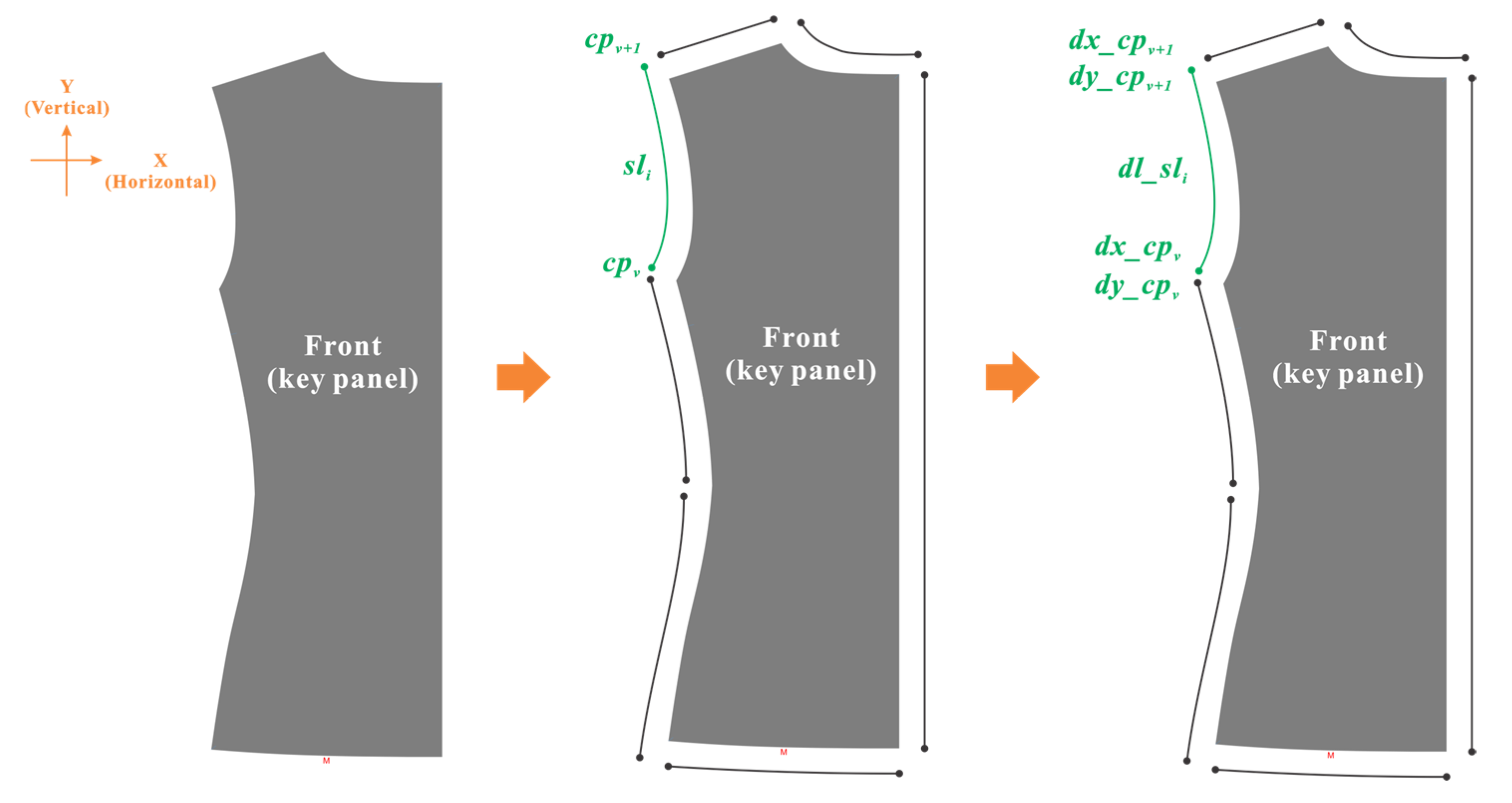



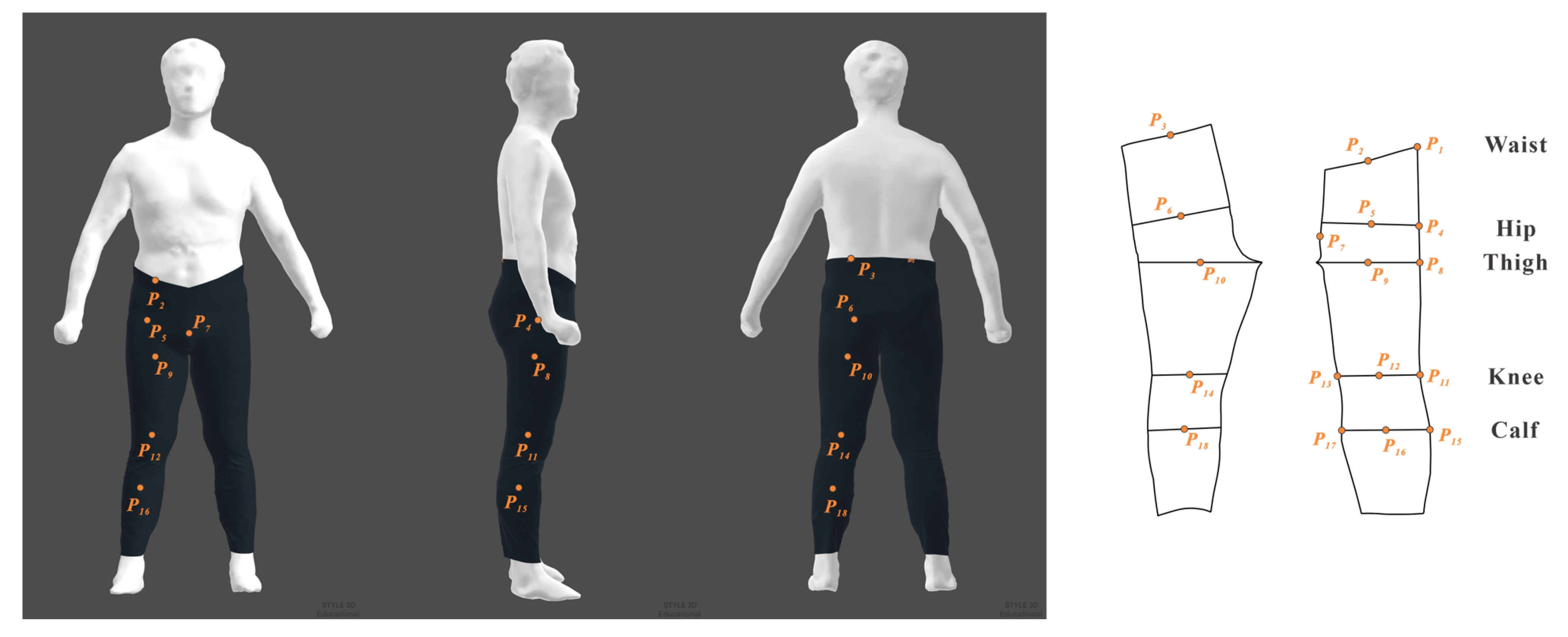
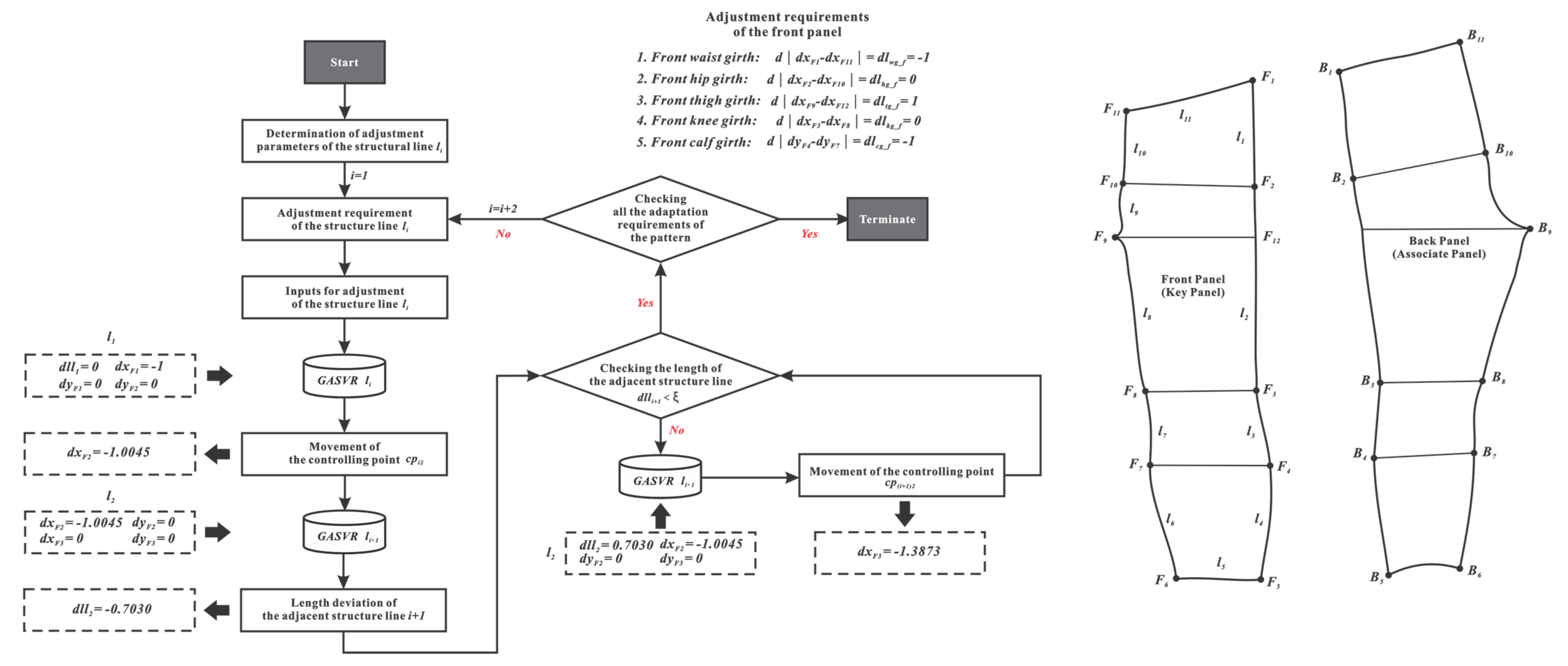


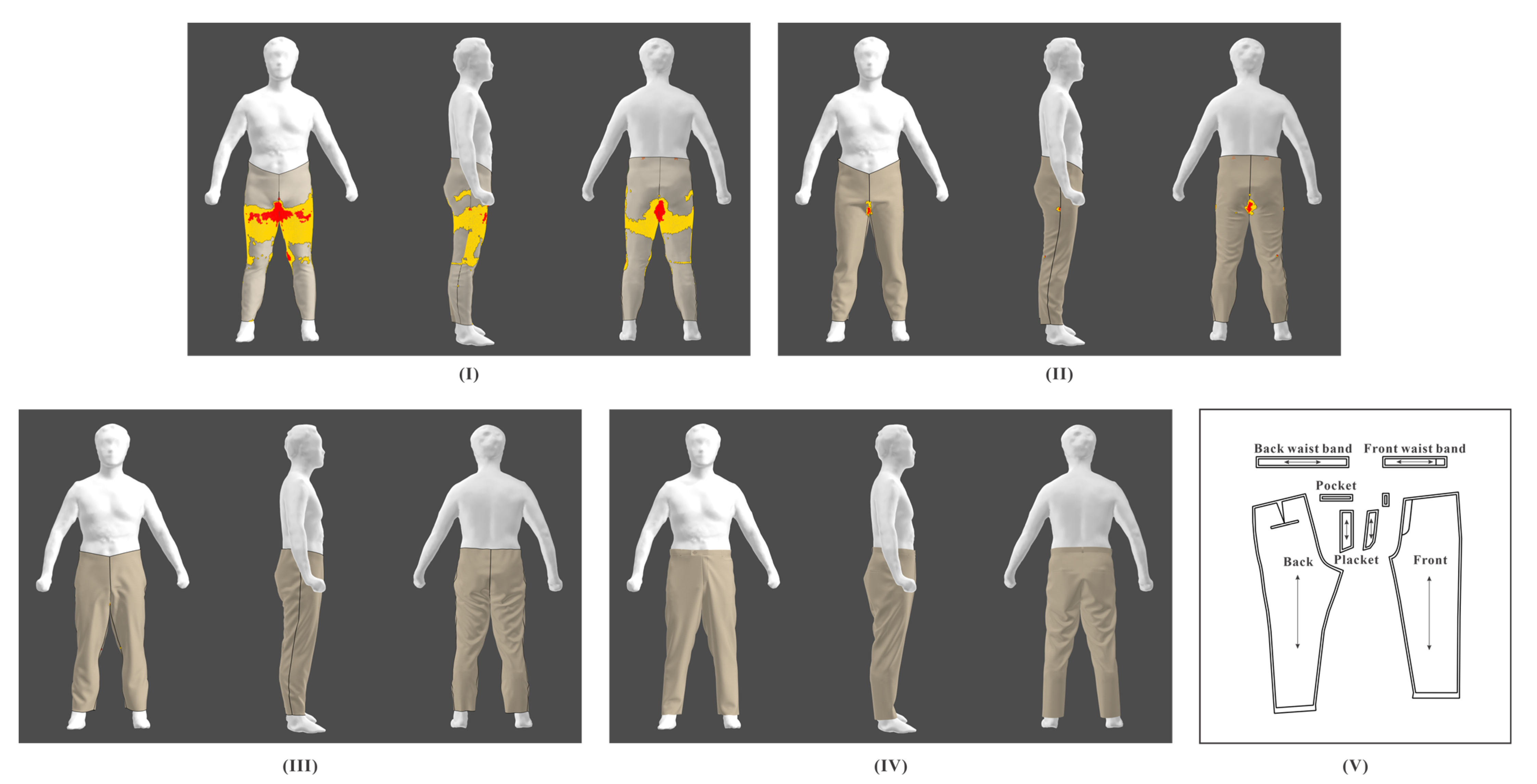
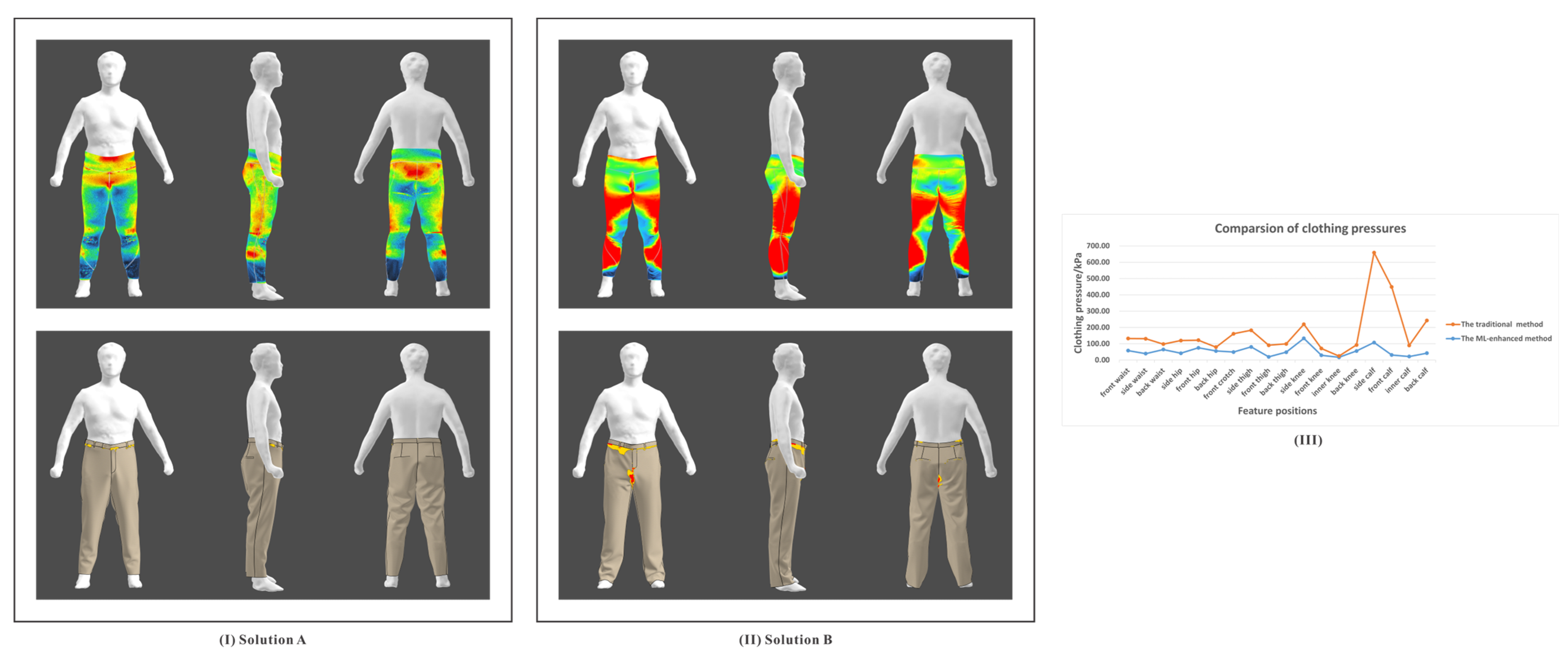

| Model Name | Input | Output |
|---|---|---|
| GASVR1 | dx_cpv, dy_cpv, dx_cpv+1, dy_cpv+1 | dl_sli |
| GASVR2 | dl_sli, dy_cpv, dx_cpv+1, dy_cpv+1 | dx_cpv |
| GASVR3 | dx_cpv, dl_sli, dx_cpv+1, dy_cpv+1 | dy_cpv |
| GASVR4 | dx_cpv, dy_cpv, dl_sli, dy_cpv+1 | dx_cpv+1 |
| GASVR5 | dx_cpv, dy_cpv, dx_cpv+1, dl_sli | dy_cpv+1 |
| S.N. | Category | Normalized Vectors | Notes | |
|---|---|---|---|---|
| Style needs | 1 | Silhouette | S shape (“S” represents Skinny.) | |
| 2 | Length | Ankle length | ||
| 3 | Waist line position | Lower waist line | ||
| 4 | Waist band | Straight waist band | ||
| 5 | Leg opening | Tapered opening | ||
| 6 | Dart | No front and back dart | ||
| 7 | Pleat | No front pleat | ||
| 8 | Yoke | Straight yoke | ||
| 9 | Ornament | No ornament | ||
| 10 | 1 | Front inserted pocket | ||
| Fit needs | Perfect |
| Controlling Points | 1st Round of Adjustment | 2nd Round of Adjustment | 3rd Round of Adjustment | ||||
|---|---|---|---|---|---|---|---|
| Horizontal Direction | Vertical Direction | Horizontal Direction | Vertical Direction | Horizontal Direction | Vertical Direction | ||
| Front side waist | −1.0000 | 0 | 0 | 0 | 0 | 0 | |
| Front side hip | −1.0045 | 0 | 0.5000 | 0.0025 | 0 | 0 | |
| Front side knee | −0.9281 | 0 | 0 | 0 | 0 | 0 | |
| Front side calf | −0.5000 | 0.0058 | 0 | 0 | 0 | 0 | |
| Front side hem | 0 | 0.0163 | 0 | 0 | 0 | 0 | |
| Front inseam hem | 0.0011 | 0.0163 | 0 | 0 | −0.5000 | 0 | |
| Front inseam calf | 0.5000 | 0.0073 | 0 | 0 | 0 | 0 | |
| Front inseam knee | −0.9281 | 0.3580 | 0 | 0 | 0 | 0 | |
| Front crotch | −1.0000 | 0.6848 | −1.0000 | 0 | −1.0000 | 0 | |
| Front center hip | −1.0045 | 0.1341 | 0.5000 | −0.7651 | 0 | −0.6939 | |
| Front center waist | 0 | 0 | 0 | 0 | 0 | 0 | |
| Back side waist | 1.0000 | 0 | 0 | 0 | 0 | 0 | |
| Back side hip | 1.0045 | 0 | −0.5000 | 0.0025 | 0 | 0 | |
| Back side knee | 0.9281 | 0 | 0 | 0 | 0 | 0 | |
| Back side calf | 0.5000 | 0.0058 | 0 | 0 | 0 | 0 | |
| Back side hem | 0 | 0.0163 | 0 | 0 | 0 | 0 | |
| Back inseam hem | −0.0011 | 0.0163 | 0 | 0 | 0 | 0 | |
| Back inseam calf | −0.5000 | 0.0073 | 0 | 0 | 0.5000 | 0 | |
| Back inseam knee | 0.9281 | 0.3580 | 0 | 0 | 0 | 0 | |
| Back crotch | 1.0000 | 0.6848 | 1.0000 | 0 | 1.0000 | 0 | |
| Back center hip | 1.0045 | 0.1341 | −0.5000 | −0.7651 | 0 | −0.6939 | |
| Back center waist | 0 | 0 | 0 | 0 | 0 | 0 | |
| Controlling Points of the Original Panel | Coordinates | Controlling Points of the Production Panel | Coordinates | |||
|---|---|---|---|---|---|---|
| Horizontal Direction | Vertical Direction | Horizontal Direction | Vertical Direction | |||
| Front 1 | ||||||
| Back | ||||||
| S.N. | Category | Normalized Vectors | Notes | |
|---|---|---|---|---|
| Style needs | 1 | Silhouette | H shape | |
| 2 | Length | Full length | ||
| 3 | Waist line position | Normal waist line | ||
| 4 | Waist band | Straight waist band | ||
| 5 | Leg opening | Straight opening | ||
| 6 | Dart | Single back dart | ||
| 7 | Pleat | No front pleat | ||
| 8 | Yoke | No yoke | ||
| 9 | Ornament | No ornament | ||
| 10 | 1 | Back inserted pocket | ||
| Fit needs | Perfect at waist girth, and loose at other feature positions |
| Controlling Points | 1st Round of Adjustment | 2nd Round of Adjustment | |||
|---|---|---|---|---|---|
| Horizontal Direction | Vertical Direction | Horizontal Direction | Vertical Direction | ||
| Front side waist | 1.0000 | 1.0000 | 0 | 0.0049 | |
| Front side hip | 1.0000 | 0.3618 | 1.0000 | 0.0061 | |
| Front side knee | 1.0000 | 0.3659 | 0 | 0.2564 | |
| Front side calf | 0 | 0 | 0 | 0 | |
| Front side hem | 0 | −0.0702 | 0 | 0.2573 | |
| Front inseam hem | −1.9947 | −0.0702 | −1.9947 | 0.2573 | |
| Front inseam calf | 0 | 0 | 0 | 0 | |
| Front inseam knee | −2.0070 | 0.3659 | −1.9935 | 0.2564 | |
| Front crotch | −1.9302 | 0 | −1.9935 | 0 | |
| Front center hip | −1.0000 | −1.1975 | −1 | −1.2033 | |
| Front center waist | 0.3841 | 1.0000 | 0 | 3.0000 | |
| Back side waist | −1.0000 | 1.0000 | 0 | 0.0049 | |
| Back side hip | −1.0000 | 0.3618 | −1.0000 | 0.0061 | |
| Back side knee | −1.0000 | 0.3659 | 0 | 0.2564 | |
| Back side calf | 0 | 0 | 0 | 0 | |
| Back side hem | 0 | −0.0702 | 0 | 0.2573 | |
| Back inseam hem | 1.9947 | −0.0702 | 1.9947 | 0.2573 | |
| Back inseam calf | 0 | 0 | 0 | 0 | |
| Back inseam knee | 2.0070 | 0.3659 | 1.9935 | 0.2564 | |
| Back crotch | 1.9302 | 0 | 1.9935 | 0 | |
| Back center hip | 1.0000 | −1.1975 | 1 | −1.2033 | |
| Back center waist | −0.3841 | 1.0000 | 0 | 0 | |
Disclaimer/Publisher’s Note: The statements, opinions and data contained in all publications are solely those of the individual author(s) and contributor(s) and not of MDPI and/or the editor(s). MDPI and/or the editor(s) disclaim responsibility for any injury to people or property resulting from any ideas, methods, instructions or products referred to in the content. |
© 2023 by the authors. Licensee MDPI, Basel, Switzerland. This article is an open access article distributed under the terms and conditions of the Creative Commons Attribution (CC BY) license (https://creativecommons.org/licenses/by/4.0/).
Share and Cite
Wang, Z.; Tao, X.; Zeng, X.; Xing, Y.; Xu, Z.; Bruniaux, P. A Machine Learning-Enhanced 3D Reverse Design Approach to Personalized Garments in Pursuit of Sustainability. Sustainability 2023, 15, 6235. https://doi.org/10.3390/su15076235
Wang Z, Tao X, Zeng X, Xing Y, Xu Z, Bruniaux P. A Machine Learning-Enhanced 3D Reverse Design Approach to Personalized Garments in Pursuit of Sustainability. Sustainability. 2023; 15(7):6235. https://doi.org/10.3390/su15076235
Chicago/Turabian StyleWang, Zhujun, Xuyuan Tao, Xianyi Zeng, Yingmei Xing, Zhenzhen Xu, and Pascal Bruniaux. 2023. "A Machine Learning-Enhanced 3D Reverse Design Approach to Personalized Garments in Pursuit of Sustainability" Sustainability 15, no. 7: 6235. https://doi.org/10.3390/su15076235
APA StyleWang, Z., Tao, X., Zeng, X., Xing, Y., Xu, Z., & Bruniaux, P. (2023). A Machine Learning-Enhanced 3D Reverse Design Approach to Personalized Garments in Pursuit of Sustainability. Sustainability, 15(7), 6235. https://doi.org/10.3390/su15076235







